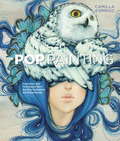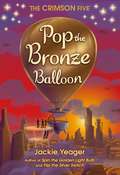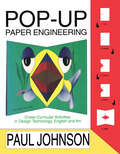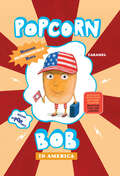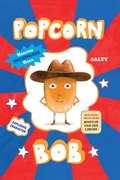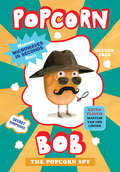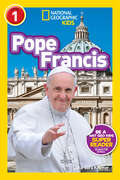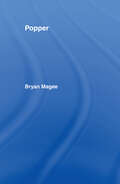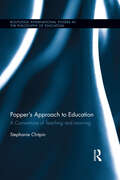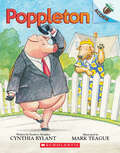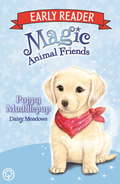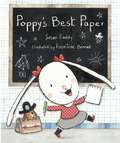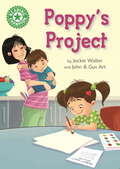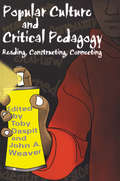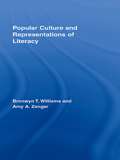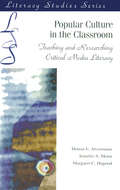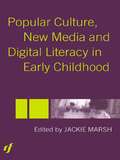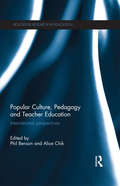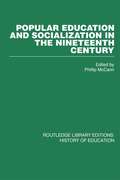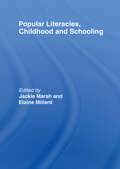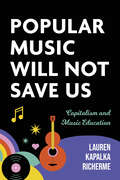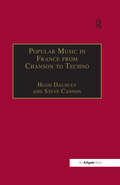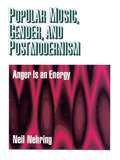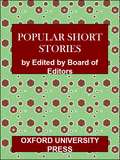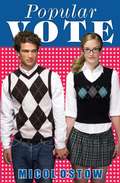- Table View
- List View
Pop Painting
by Camilla D'ErricoA unique behind-the-scenes guide to the painting process of one of the most popular artists working in the growing, underground art scene of Pop Surrealism.Painting superstar Camilla d'Errico opens up her studio and offers readers an insider scoop on the tools, techniques, and inspirations she draws from to create stunningly beautiful, otherworldly works of art. Pop Surrealism, with its unique blend of high art and popular culture, has been a growing force in the art world for years. Artists working in Pop Surrealism use elements of manga, cartoons, movies, and more to produce paintings that have been displayed in galleries and purchased by collectors around the globe. In addition to her work in manga and as the author of the best-selling Pop Manga, d'Errico is also one of the Pop Surrealism movement's biggest names. From high-end art galleries to comic book conventions, d'Errico's works draw legions of fans, collectors, and admirers. With Pop Painting, fans and aspiring painters get an up-close look at the step-by-step processes she employs to transform oil and acrylic paints into unforgettable images of her ethereal and beautiful characters. This one-of-a-kind look at a painter at the top of her field reveals all the materials and methods readers need to join the ranks of the Pop Surrealism movement.From the Trade Paperback edition.
Pop the Bronze Balloon (The Crimson Five #3)
by Jackie YeagerThe Crimson Five make their International Debut! Kia Krumpet and her team of young inventors embark on the Swirl and Spark Creativity Tour, the highest level of the Piedmont Challenge. To solidify their spots at the Piedmont Inventor's Prep School once and for all, they're challenged to create a final life-changing invention with Team France and Team Switzerland. Everything changes when the Crimson Five discover that someone else is pulling the strings in the competition—and a hidden invention with a secret. In order to save Piedmont, and the futures of all kids with big dreams around the world, Kia, Ander, Mare, Jax, and Jillian must find a way to unlock the invention and lead a new connected team—the ultimate test of imagination and teamwork. The Crimson Five are traveling the globe. Because a dream is born to become a dream come true.
Pop-Up Paper Projects: Step-by-step paper engineering for all ages
by Paul JohnsonThe techniques of creating pop-up forms are demonstrated in a series of practical lessons. The book also suggests ways in which pop-up forms can be used to enrich the study of English and art, and contains illustrations of childrens work.
Popcorn Bob 3: In America
by Maranke RinckEllis, Dante, and Popcorn Bob are on an important top-secret mission in America. (Ellis's dads are there too. But they don't know about the mission.)When Popcorn Bob last escaped the clutches of Coraline Corn (the evil owner of Popcorn & Co.), she said that there are more live popcorn kernels in America – just like Bob!Bob can't wait to meet his family. But when he finds them, they're trapped in a chicken coop on the Popcorn & Co. grounds, living at the mercy of Coraline Corn, and whatever experiments she wants to run on them. Bob, Ellis, and Dante must team up once again to defeat Coraline Corn and free Bob's newfound family.The third installment to this chapter book series brings back all the zaniness that readers know and love, plus a new cross-continental adventure, and lots more friends.
Popcorn Bob: The Popcorn Spy
by Maranke Rinck Martijn van der LindenEllis loves popcorn. Who doesn't?But one day her school goes on a healthy eating campaign and her dads decide to follow suit, banning all snack foods from their house, INCLUDING POPCORN. Unfair. Ellis has got to get around that edict, so one night she pops a bag of popcorn out back in the garage...and she's met with more than just her favorite salty snack. One kernel refuses to pop, and soon it's sprouted a face, arms, and legs! He introduces himself as Popcorn Bob, and he is NOT in a good mood. (Ever, really.) He's absolutely ravenous, and no amount of food keeps him from being hangry. Bob causes no end of chaos for Ellis, and she decides to rid herself of him once and for all, except...she actually starts to like him.A chapter book for all ages, Popcorn Bob is a laugh-out-loud story about the power of friendship, and a perfect bowl of popcorn.
Popcorn Bob: The Popcorn Spy (Popcorn Bob Ser. #2)
by Maranke RinckEllis is now best friends with a grumpy, talking popcorn kernel. Yes, REALLY!Together, they're secretly handing out popcorn to Ellis's classmates (since her school is now officially a "Healthy School"—blech), and everything is great. Bob is even learning how to control his hanger. (Kind of.) But Ellis and Bob are in danger—visitors from the possibly nefarious Popcorn & Co. are following them, and it's clear they're after Bob!Will Ellis be able to keep Bob out of their clutches?
Pope Francis (Readers Bios)
by Barbara KramerMeet Pope Francis. Born Jorge Mario Bergoglio in Buenos Aires, Argentina, Pope Francis is the first Pope from the Americas. He's also the first Pope to replace a living one! Learn all about the Pontiff in this level 1 reader, carefully leveled for an early independent reading or read aloud experience.
Popper Cb: Popper (Modern Masters Ser.)
by Brian MageeFirst published in 1974. Routledge is an imprint of Taylor & Francis, an informa company.
Popper's Approach to Education: A Cornerstone of Teaching and Learning (Routledge International Studies in the Philosophy of Education #38)
by Stephanie ChitpinChallenging the theory of induction in teacher education, this book proposes a knowledge-building framework based on the critical rationalism of philosopher of science, Karl Popper. The Objective Knowledge Growth Framework developed in this book is designed to be an effective critical analysis framework for empowering teachers and schools to build and share professional knowledge. This book is essential reading for educational scholars, researchers, professionals, policymakers, and all those interested in exploring the application of Popperian philosophy to the field of education and re-envisioning educational practice.
Poppleton: An Acorn Book (Poppleton #1)
by Cynthia RylantPick a book. Grow a Reader!This series is part of Scholastic's early reader line, Acorn, aimed at children who are learning to read. With easy-to-read text, a short-story format, plenty of humor, and full-color artwork on every page, these books will boost reading confidence and fluency. Acorn books plant a love of reading and help readers grow!Meet Poppleton -- he's the new pig in town! He makes friends with his new neighbor, Cherry Sue. He goes to the library every Monday to read adventure stories. And he helps his friend Fillmore take his medicine when he is sick. This Acorn edition contains brand-new content, including story prompts and how-to-draw pages!
Poppy Muddlepup: Book 5 (Magic Animal Friends Early Reader #5)
by Daisy MeadowsThe much-loved series from the creator of Rainbow Magic - abridged for younger readers and illustrated in full colour!Welcome to a magical world where animals talk and play - just like you and me!Best friends Jess and Lily love all animals. But when they follow a mysterious golden cat into Friendship Forest - a place where animals live in tiny cottages and sip dandelion tea at the Toadstool Cafe - their animal friends suddenly become much more magical!Fluffy puppy Poppy Muddlepup needs help! Can the girls rescue Poppy's brother from Grizelda the witch?
Poppy's Best Paper (Live Oak Media Ereadalong Ser.)
by Susan EaddyFans of Olivia and Lilly will delight in Poppy, a little rabbit with big dreams—and an even bigger personality.More than anything, Poppy wants to be a verrrry famous writer. She's sure Mrs. Rose will pick her paper to read to the whole class! Trouble is, she has tall ambitions but is short on effort, and her jealousy takes over when her best friend's paper is chosen instead. In the end, Poppy discovers that she has to get out of her own way if her big dreams are going to come true. Rosalinde's adorable, expressive illustrations make memorable, quirky Poppy a real star!
Poppy's Project: Independent Reading Green 5 (Reading Champion #113)
by Jackie WalterIn this story, Poppy has a project to do for school. She has some great ideas, but everything keeps going wrong. Luckily, Mum and Dad can help as well.Reading Champion offers independent reading books for children to practise and reinforce their developing reading skills.Fantastic, original stories are accompanied by engaging artwork and a reading activity. Each book has been carefully graded so that it can be matched to a child's reading ability, encouraging reading for pleasure.Independent Reading Green stories are perfect for children aged 4+ who are reading at book band 5 (Green) in classroom reading lessons.
Popular Culture and Critical Pedagogy: Reading, Constructing, Connecting (Pedagogy and Popular Culture #Vol. 2)
by John A. Weaver Toby DaspitThis collection attempts to incorporate cultural studies into the understanding of schooling, not simply addressing how students read themselves as "members" of a distinct culture, but how they, along with teachers and administrators, read popular texts in general. The purpose of this book is to suggest some alternative directions critical pedagogy can take in its critique of popular culture by inviting multiple reading of popular texts into its analysis of schooling and seeing many forms of popular culture as critical pedagogical texts.
Popular Culture and Representations of Literacy (Routledge Research in Literacy)
by Bronwyn Williams Amy ZengerMovies are filled with scenes of people of all ages, sexes, races, and social classes reading and writing in widely varied contexts and purposes. Yet these scenes go largely unnoticed, despite the fact that these images recreate and reinforce pervasive concepts and perceptions of literacy. This book addresses how everyday literacy practices are represented in popular culture, specifically in mainstream, widely-distributed contemporary movies. If we watch films carefully for who reads and writes, in what settings, and for what social goals, we can see a reflection of the dominant functions and perceptions that shape our conceptions of literacy in our culture. Such perceptions influence public and political debates about literacy instruction, teachers' expectations of what will happen in their classrooms, and student's ideas about what reading and writing should be.
Popular Culture in the Classroom: Teaching and Researching Critical Media Literacy (IRA's Literacy Studies Series)
by Donna E. Alvermann Jennifer S. Moon Margaret C. Hagwood Margaret C. HagoodThis book is written for teachers, researchers, and theorists who have grown up in a world radically different from that of the students they teach and study. It considers the possibilities involved in teaching critical media literacy using popular culture, and explore what such teaching might look like in your classroom. Published by International Reading Association
Popular Culture, New Media and Digital Literacy in Early Childhood
by Jackie MarshThis book offers a range of perspectives on children's multimodal experiences, providing a ground-breaking account of the ways in which children engage with popular culture, media and digital literacy practices from their earliest years. Many young children have extensive experience of film, television, printed media, computer games, mobile phones and the Internet from birth, yet their reaction to media texts is rarely acknowledged in the national curricula of any country. This seminal text focuses on children from birth to eight years, addressing issues such as: * media and identity construction* media literacy practices in the home* the changing nature of literacy in technologically advanced societies* The place of popular and media texts in children's lives and the use of such texts in the curriculum. By exploring children's engagement with popular culture, media and digital texts in the home, community and early years settings, the contributors look at empirical studies from around the world, and draw out vital new theoretical issues relating to children's emergent techno-literacy practices. With an unmatchable team of international experts evaluating topics from text-messaging to the Teletubbies, this book is a long-overdue, fascinating and illuminating read for policy-makers, educational researchers and practitioners, and crosses over to appeal to those in the linguistics field.
Popular Culture, Pedagogy and Teacher Education: International perspectives (Routledge Research in Education)
by Phil Benson Alice ChikThe integration of popular culture into education is a pervasive theme at all educational levels and in all subject areas. Popular Culture, Pedagogy and Teacher Education explores how ‘popular culture’ and ‘education’ come together and interact in research and practice from an interdisciplinary perspective. The international case studies in this edited volume address issues related to: how popular culture ‘teaches’ our students and what they learn from it outside the classroom how popular culture connects education to students’ lives how teachers ‘use’ popular culture in educational settings how far teachers should shape what students learn from engagement with popular culture in school how teacher educators can help teachers integrate popular culture into their teaching Providing vivid accounts of students, teachers and teacher educators, and drawing out the pedagogical implications of their work, this book will appeal to teachers and teacher educators who are searching for practical answers to the questions that the integration of popular culture into education poses for their work.
Popular Education and Socialization in the Nineteenth Century
by Phillip McCannOriginally published in 1977, this volume analyzes aspects of elementary schooling in the nineteenth century and the ways in which it prepared working-class children for life in industrial Britain. The book examines: The procedures and practices of different types of schools. The ideologies guiding elementary education The social implications of curriculum content and pupils’ and parents’ attitudes to the education provided by the church and state.
Popular Literacies, Childhood and Schooling
by Jackie Marsh Elaine MillardThis bold, forward-thinking text offers a clear rationale for the development of curricula and pedagogy that will reflect young people’s in-school and out-of-school popular culture practices. By providing a sound theoretical framework and addressing popular culture and new technologies in the context of literacy teacher education, this book marks a significant step forward in literacy teaching and learning. It takes a cross-disciplinary approach and brings together contributions from some of the world’s leading figures in the field. Topics addressed include: children’s popular culture in the home informal literacies and pedagogic discourse new technologies and popular culture in children’s everyday lives teachers working with popular culture in the classroom. This book illustrates the way in which literacy is evolving through popular culture and new technology and is an influential read for teachers, students, researchers and policy makers.
Popular Music Will Not Save Us: Capitalism and Music Education (Counterpoints: Music and Education)
by Lauren K. RichermeIn today's globalized landscapes, both traditional and progressive K–12 music education practices, including those associated with popular music, can further capitalism-related inequities. In this context, music educators and students might consider how they position themselves and their music-making practices in relation to capitalist aims and processes and confront the more unethical aspects of capitalism.Popular Music Will Not Save Us challenges music educators to rethink their philosophical stances in the face of contemporary capitalist values and explores the intersection of music education and globalized capitalism, unveiling how certain practices exacerbate material inequities and erode social responsibility. As author Lauren Kapalka Richerme unravels the complexities of music education, her analysis sheds light on how prevalent practices can inadvertently uphold capitalist ideals and reinforce individualism, unceasing accumulation, and precarity in the workforce. Given that no musical genre inherently challenges problematic aspects of capitalism, Richerme proposes that music educators instead focus on affective flows, or the circulation of sensations within pedagogical spaces, and consider four alternative positionalities: thriving within, surviving under, resisting, and challenging capitalism.Popular Music Will Not Save Us advocates for a shift away from capitalistic individualism and inequities and toward a more equitable, affective pedagogical mode. Now is the time to transcend traditional boundaries and embrace a new paradigm that prioritizes social impact over commercial gain.
Popular Music in France from Chanson to Techno: Culture, Identity and Society (Ashgate Popular And Folk Music Ser.)
by Hugh DaunceyIn France during the 1960s and 1970s, popular music became a key component of socio-cultural modernisation as the music/record industry became increasingly important in both economic and cultural terms in response to demographic changes and the rise of the modern media. As France began questioning traditional ways of understanding politics and culture before and after May 1968, music as popular culture became an integral part of burgeoning media activity. Press, radio and television developed free from de Gaulle's state domination of information, and political activism shifted its concerns to the use of regional languages and regional cultures, including the safeguard of traditional popular music against the centralising tendencies of the Republican state. The cultural and political significance of French music was again revealed in the 1990s, as French-language music became a highly visible example of France's quest to maintain her cultural 'exceptionalism' in the face of the perceived globalising hegemony of English and US business and cultural imperialism. Laws were passed instituting minimum quotas of French-language music. The 1980s and 1990s witnessed developing issues raised by new technologies, as compact discs, the minitel telematics system, the internet and other innovations in radio and television broadcasting posed new challenges to musicians and the music industry. These trends and developments are the subject of this volume of essays by leading scholars across a range of disciplines including French studies, musicology, cultural and media studies and film studies. It constitutes the first attempt to provide a complete and up-to-date overview of the place of popular music in modern France and the reception of French popular music abroad.
Popular Music, Gender and Postmodernism: Anger Is an Energy
by Dr Neil R. NehringThe migration of cynical academic ideas about postmodernism into music journalism are traced in this book. The result of this migration is a widespread fatalism over the ability of the music industry to absorb any expression of defiance in popular music. The book synthesizes a number of fields: American and British academic and journalistic music criticism; aesthetic and literary history and theory from romanticism through postmodernism; alternative music such as feminist punk and grunge; political economy, which has fueled the obsession with commercial incorporation; and subcultural sociology.
Popular Short Stories
by Edited by Board of EditorsThis collection of short stories mainly focuses on characters and situations familiar in modern life. Many readers cannot appreciate stories that gave delight to an older generation. The types of schools and law-courts that Dickens, for instance, describes in his novels are relics of the past; his Victorian characters are difficult to recognize in a modem situation. Young people today therefore find that those novels do not communicate with them personally. We hope that this selection of narratives of situations and description of persons from modern society will appeal and relate to young readers.
Popular Vote
by Micol OstowIn an election year, Erin Bright sets aside her familiar supporting role as daughter of the mayor and girlfriend of the student body president to stand up for what she believes in and protect an historic park from being replaced by a gas station.
